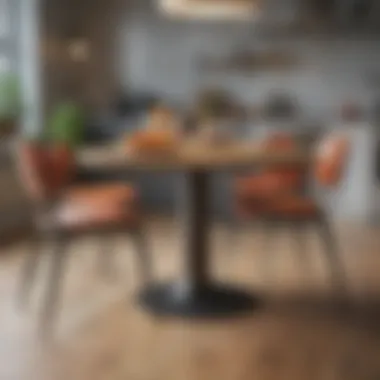Optimal Dining Table Shapes for Small Spaces


Intro
In contemporary living spaces, especially smaller ones, the selection of an appropriate dining table significantly impacts both functionality and aesthetics. Choosing a dining table shape that complements your space involves understanding various configurations and how they interact with the surrounding environment. This analysis aims to clarify the relationship between table shapes, their practical benefits, and visual appeal, ultimately guiding you toward making an informed decision.
Understanding optimal dining table shapes is crucial for maximizing space while maintaining a pleasing design. Round, square, and rectangular tables each present unique advantages and drawbacks based on the specific dimensions and layout of your room. Furthermore, a table's size, material, and arrangement can dramatically influence how effectively a small space is utilized.
As dining tables serve as central pieces in most homes, it is essential to evaluate how their shapes accommodate both daily activities and occasional gatherings. This comprehensive guide will navigate through the various shapes one can consider along with their respective impacts, thus equipping readers with the knowledge necessary to make a choice that harmonizes with their living arrangements.
Understanding the Importance of Table Shape
Selecting the right dining table shape goes beyond mere aesthetics; it encompasses functionality and practicality advantages that can significantly enhance the usability of compact spaces. In a world where living areas are increasingly becoming smaller, the shape of the dining table plays a crucial role in maximizing the available space while providing a comfortable dining experience.
When considering table shape, it is essential to evaluate how it serves its purpose. The right shape can offer a better flow in the room, allowing for easier movement and accommodating guests more comfortably.
Functionality vs. Aesthetics
The debate between functionality and aesthetics often surfaces when choosing a table. Functionality refers to how well the table meets the user's needs, such as seating capacity, ease of mobility, and versatility in use. On the other hand, aesthetics reflects the visual appeal and how the table integrates with the overall decor of the space.
A well-designed table should ideally blend both elements. Here are key points to consider:
- User Needs: Assess whether the table is primarily for everyday meals, formal dining, or both. This will influence the shape and design.
- Space Constraints: The dimensions of the area dictate what shape will fit best. Compact configurations may hinder movement if not considered carefully.
- Design Cohesion: The table should match or complement existing furniture styles to create a unified look in the dining area.
Space Optimization in Small Areas
In small areas, optimizing space is vital. Table shape significantly affects how efficiently a room is used. Round, square, and rectangular tables each have their unique advantages.
- Round Tables: They occupy less space and facilitate conversation by allowing everyone to see each other. They also eliminate corners, making them safer and more accessible.
- Square Tables: These can easily fit into corners or nooks, providing a contemporary look and often doubling as a workspace.
- Rectangular Tables: They offer ample surface area for larger gatherings, making them suitable for versatile usage if the space allows.
Using the right table shape can turn a compact space into a functional haven for dining. Careful consideration of how each shape interacts with the environment and meets specific needs can lead to a more accommodating and pleasant dining experience.
"Choosing the right table shape can transform not only how a space looks but also how it feels and functions."
Understanding the importance of table shape is a foundational step toward optimizing dining experiences in compact areas.
Evaluating Dining Table Shapes
Evaluating dining table shapes is a crucial aspect of furnishing compact spaces. The shape of a dining table directly impacts functionality, aesthetic appeal, and how well the space is utilized. In small areas, where every square foot counts, selecting the optimal shape can make the difference between a cramped feeling and a well-organized dining area. Different shapes offer unique benefits and considerations that cater to various needs and preferences.
Round Tables
Benefits of Round Tables
Round tables are often hailed for their versatility. They promote easier interaction among diners. The lack of corners provides more seating options, which is ideal for small spaces. A round table can also create an inviting atmosphere, fostering conversation. It does not dominate the room, allowing for a more open feel. This characteristic makes round tables a popular choice in compact dining areas, as they blend seamlessly into the layout.
Considerations for Round Tables
However, round tables also come with considerations. They may have limitations in seating capacity compared to rectangular options. Moreover, they require more space for dining chairs to be pulled out comfortably. An important aspect to consider is the table size—if it is too large, it can overwhelm the room. Thus, careful measurement is essential when integrating round tables into smaller spaces.
Square Tables
Benefits of Square Tables


Square tables present a unique solution for spatial challenges. They generally fit well in corners or against walls, maximizing floor space. One key benefit is their symmetry, providing balance to an area. This shape can also easily accommodate four people, making it efficient for small gatherings. Because of their compact design, square tables are often an advantageous selection for those with limited space.
Considerations for Square Tables
The main downside is that square tables can feel restrictive, especially as guest numbers increase. Their inability to seat more than four comfortably may limit their use for larger gatherings. Additionally, a square table's fixed shape means less flexibility in accommodating different seating arrangements. Understanding these limitations is crucial to making an informed decision.
Rectangular Tables
Benefits of Rectangular Tables
Rectangular tables are often favored for their adaptability in various spaces. They can be placed along a wall or in a center location, allowing for multiple seating configurations. The elongated shape can accommodate larger groups, making it suitable for families or entertaining guests. Their design promotes a more formal dining experience, aligning well with various decor styles, which further enhances their appeal.
Considerations for Rectangular Tables
Nonetheless, rectangular tables might consume more floor space. In narrow rooms, they can create a bottleneck effect, reducing walkways. Seating can become complicated if the table is too long, as guests at either end may feel disconnected. Therefore, evaluating the dimensions of the room is vital when considering this option.
Oval Tables
Benefits of Oval Tables
Oval tables represent a harmonious blend of round and rectangular designs. They often seat more people than round tables while maintaining a softer appearance that can enhance the visual flow in compact spaces. Their unique shape minimizes sharp edges, making them safer in households with children. This design encourages interaction while maximizing the number of guests at the table, thus rendering it a practical choice.
Considerations for Oval Tables
Yet, oval tables can present their own challenges. Depending on their size, they can still take up significant space. In smaller rooms, they may not fit as seamlessly as other shapes. Additionally, the variety in oval sizes means that careful selection is essential to ensure functionality. Understanding the existing furniture layout is also key to integrating an oval table effectively.
Determining the Right Size
Choosing the right size for a dining table in compact spaces is vital. The size affects not only functionality but also the overall flow of the area. A table that is too large can overwhelm a small room, while a table that is too small may not serve its intended purpose. Moreover, understanding how to measure your space accurately and determine seating capacity ensures that the table fits both the aesthetic and practical needs of the environment.
Measuring Your Space
Measuring your space is the first step in selecting an appropriate dining table. Start by evaluating the dimensions of your room. Consider both width and length, as well as any architectural features like doors, windows, and built-in furniture that might affect the arrangement.
- Use a tape measure: Measure the length and width of the dining area. Be crucial about noting the dimensions.
- Identify layout options: Visualize different table placements. Allow for walking space and maintenance areas. Aim for at least 36 inches of clearance around the table for comfortable movement.
- Sketch a floor plan: Draw a simple floor plan including all furniture pieces. This can help you visualize how a new table will fit in the space.
Successful measurements lead to better table choices. A perfectly sized table maximizes utility while maintaining the room’s harmony.
Determining Seating Capacity
Understanding seating capacity is equally important as measuring your space. The number of people you want to accommodate directly influences your table size.
- Standard space per person: Generally, allow 24 inches of table width per person for comfortable dining.
- Table shape considerations: Different shapes have various seating capabilities. For instance, a round table typically seats less than a rectangular one of the same dimensions. Analyze what shape fits your needs best.
- Future needs: Consider future gatherings. If you frequently host guests, think about expanding table options that can fit more people.
In small dining areas, knowing how many people you want to serve helps when selecting and arranging the table. An incorrect capacity can result in uncomfortable dining experiences, limiting functionality.
"Choosing the right size dining table means considering both current needs and future possibilities."
Proper measurement and a clear understanding of seating capacity set the foundation for selecting a dining table that enhances the compact space rather than detracts from it.
Materials and Their Impact


The choice of material for a dining table significantly influences both the aesthetic appeal and functional utility within compact spaces. When selecting materials, it is essential to consider durability, maintenance, and style. Different materials can either enhance the feel of the space or clutter it, thus understanding their impact is crucial. Moreover, materials can affect acoustics, warmth, and overall ambiance. In addition, how these materials complement existing furniture further determines the success of integrating the table into the space.
Wood as a Dominant Choice
Wood is often regarded as the most popular choice for dining tables, particularly in compact settings. The reasons for this popularity include its natural aesthetics and versatility. Wood adds warmth and character to any space, making it feel inviting. Its variety, from oak to walnut, allows for a broad range of styles from rustic to modern.
However, there are important considerations to take into account:
- Durability: Solid wood tends to be more durable than engineered wood or laminates. It withstands wear and tear well, provided it is properly maintained.
- Weight: Heavier woods can provide stability but may also pose challenges in moving or rearranging the table as needed in smaller spaces.
- Maintenance: Wood surfaces may require regular treatment with oils or sealants to prevent scratches and stains, especially in dining areas that see frequent use.
Despite these considerations, the aesthetic and tactile appeal of wood often outweighs potential downsides for many. Thus, it remains a top choice for anyone looking to create a cozy dining area.
Metal and Glass Options
Metal and glass tables offer a striking alternative to traditional wood designs. While less common, their advantages might make them perfect for smaller spaces.
- Visual Lightness: Glass, particularly, creates an illusion of more space due to its transparency, making it suitable for compact environments. Metal bases can also add sleek lines, contributing to a modern aesthetic that does not overwhelm a room.
- Durability: Metal can withstand significant wear and tear. It's often treated to resist corrosion or rust, making it a practical option.
- Easier Maintenance: Glass surfaces can usually be cleaned with little effort. Unlike wood, they don’t absorb spills, which can be beneficial in preventing stains.
Yet, there are drawbacks as well:
- Fragility: Glass can be prone to chipping and breaking, which necessitates careful handling and consideration of household environments, especially with children.
- Cold Aesthetic: Some may find metal and glass tables less cozy, which could be a concern for those wanting a more inviting space.
In summary, selecting the right material for dining tables in compact spaces requires thoughtful consideration. Choices from wood to metal and glass each bring distinct advantages and limitations that can define how a small area functions and feels.
Layout Considerations
When choosing the perfect dining table for compact spaces, layout considerations are crucial. The arrangement of your dining table can significantly influence not just the aesthetics but also the function of your space. Properly evaluating the layout can lead to enhancements in comfort, style, and practicality.
Complementing Other Furniture
In smaller areas, every piece of furniture should work together synergistically. A dining table should harmonize with existing furniture pieces, such as chairs, sideboards, and shelving units. For instance, if the other furniture pieces are minimalist, a bulky table can disrupt the overall flow.
To integrate a dining table effectively, you might think about:
- Scale: Ensure that the table doesn’t overwhelm the room. A table that is too large can make the area feel cramped.
- Design: Match materials and styles. A glass table can pair well with modern decor. In contrast, a wooden table may suit a rustic setting better.
- Functionality: Consider how the table complements the daily activities in the space. Will it serve as a workspace or a dining area primarily?
The goal is to create an inviting atmosphere where the dining table feels part of the overall room design, rather than an afterthought.
Ventilation and Walk Space
Ventilation and walk space should not be underestimated. A dining table in a compact space needs adequate room for movement and airflow. Poor layout could lead to a cluttered and uncomfortable environment. Here are some aspects to keep in mind:
- Spacing Around the Table: Ensure there is sufficient walk space around the table. Ideally, you want at least 36 inches between the table and surrounding walls or furniture. This distance allows people to move freely.
- Airflow: A well-ventilated area contributes to comfort, especially during gatherings that involve food. A crowded setting can lead to heat buildup, making the space uninviting.
- Accessibility: Ease of access to the table is important. If chairs are pushed in too far or the space feels tight, it can discourage use. A table design that allows easy entry and exit is preferable.
Proper layout can transform even the smallest dining area into a functional dining experience, maximizing every inch of available space.
In summary, layout considerations influence both the practical use of the dining table and the overall ambiance. By complementing existing furniture and ensuring adequate ventilation and movement, the dining experience can be significantly elevated.
Versatility in Usage
The consideration of versatility in dining table shapes is critical for compact spaces. A flexible table can serve multiple functions while adapting to various occasions. In a small apartment or home, one piece of furniture should not be limited to a singular purpose. It should enhance the space while providing room for social interaction, work, and dining without feeling cramped.


Multi-Functional Tables
Multi-functional tables have gained popularity among design enthusiasts. These tables often serve dual purposes, merging dining with workspace or leisure activities. For instance, a dining table that doubles as a desk allows for smooth transitions between eating and working, especially in a compact area. These designs maximize the utility of limited square footage, making them ideal for urban living.
Benefits of multi-functional tables include:
- Adaptability: Users can easily alter their use depending on the need, saving space and reducing clutter.
- Aesthetic Appeal: Many designs integrate seamlessly with the decor, showcasing remnants of craftsmanship and stylish features.
- Simplicity: Maintaining a clean and organized atmosphere is achievable as fewer furniture pieces are utilized.
Choosing the right multi-functional table involves assessing personal requirements. One should consider how often one needs both occasions and which activities are most important. For example, if entertainment is a primary focus, then a larger surface that can accommodate dining and games might be more beneficial compared to a smaller desk-like surface.
Expandable Designs
Expandable dining tables provide another layer of versatility for those with limited dining space. These tables come in a fixed size but can expand when needed, allowing for more guests during gatherings. The ability to extend the size of a table enhances its practicality and contributes to more enjoyable social experiences.
Some key considerations for expandable designs include:
- Mechanism: It is important to choose a reliable and easy-to-use extension system. Some models use a folding mechanism, while others might involve sliding components.
- Material Durability: The table's material should withstand frequent adjustments, maintaining both functionality and appearance over time.
- Size Options: Consider the various sizes that the table can adopt. It should comfortably fit within the space when in its compact form but have the capacity to accommodate additional guests with ease.
"A versatile dining table transcends the mere act of eating; it becomes a centerpiece for life’s moments, no matter how intimate or grand."
Style Integration
The concept of style integration is crucial when selecting dining tables for compact spaces. It involves ensuring that the table complements the overall decor and enhances the aesthetic appeal of the room. In smaller areas, where every element contributes to the visual atmosphere, choosing a table that aligns with specific styles becomes even more important. By harmonizing the table design with existing furniture and room characteristics, one can create a cohesive look that feels intentional rather than haphazard.
The benefits of style integration are clear. A well-chosen table not only serves a functional purpose but also acts as a focal point. Moreover, it can enhance the feeling of spaciousness. A minimalist table design, for instance, can make a room feel airier, while ornate styles may overwhelm smaller spaces. Also, understanding personal preferences in design can tailor choices even further, making the dining experience enjoyable and visually stimulating.
Modern vs. Traditional Styles
When it comes to dining tables, modern and traditional styles offer distinct appeals. Modern styles often feature clean lines and a more utilitarian approach. They utilize materials such as metal and glass, showcasing simplicity without excess decoration. This approach can keep small spaces looking uncluttered. On the other hand, traditional styles typically reflect craftsmanship with intricate woodwork and classic shapes. These tables can add warmth and richness to a room, making it feel inviting.
Individuals should think about the existing decor when choosing between these styles. Modern tables can work well in contemporary settings; however, they may clash with vintage decor. Traditional tables may fit seamlessly in rooms styled with classic furnishings, yet they could dominate the visual space in more modern setups. Ultimately, the decision between modern and traditional styles must consider both functionality and aesthetic harmony.
Color Schemes and Themes
The color scheme of a dining table significantly impacts the feel of the space. Tables in lighter hues can create a sense of openness, while darker shades can transmit coziness and sophistication. For compact areas, using tables that blend with the room's color palette is advisable. This connection reduces visual clutter and makes the area look more expansive.
Incorporating different textures and materials can add depth to the design, even within the same color theme. For example, a light wood table can contrast beautifully with darker chairs or a colorful tablecloth. Also, integrating different colors from the surrounding decor into the table design can enhance visual interest without overwhelming a small space.
"In small spaces, every choice counts. The right dining table can greatly influence the overall atmosphere."
Choosing a theme for the dining area is an essential final touch. Whether one leans toward a rustic farmhouse vibe or a sleek urban minimalism, ensuring the table aligns with these concepts can boost the charm and functionality of the environment. It creates a dining experience that resonates with the occupants and enriches the overall decor.
End
Summarizing Key Findings
To summarize the essential findings from our exploration:
- Round Tables: These provide a welcoming atmosphere and enable better interaction among diners. However, they may not maximize seating capacity in tighter spaces.
- Square Tables: They offer symmetry and adaptability, fitting well in small, square-shaped areas. However, they may limit movement around the table compared to other shapes.
- Rectangular Tables: Ideal for narrow spaces, they allow for more diners than a square table. Yet, they can be cumbersome if the room layout doesn’t accommodate their length.
- Oval Tables: They combine the benefits of rectangular tables with the softer edges of round tables. Their versatility, however, can sometimes lead to difficulties in fitting them perfectly within a room.
Recognizing these attributes empowers individuals to make informed decisions tailored to their specific living arrangements and needs.
Final Recommendations
When selecting a dining table for compact spaces, consider the following:
- Measure Your Space: Accurately determine dimensions to ensure that the table fits well without overwhelming the area. It’s prudent to leave some room for movement.
- Evaluate Seating Needs: Understand how many people typically dine together. This will guide you in choosing a table that accommodates everyone comfortably.
- Choose Functional Designs: Look for multi-functional or expandable tables. This adds versatility to your dining experience without sacrificing space.
- Select Appropriate Materials: While wood offers a classic appeal, metal and glass can create an illusion of a larger space.
Ultimately, the selection of the right dining table shape must align with your lifestyle and the spatial constraints of your environment. This nuanced approach will ensure that the dining experience remains enjoyable while maximizing limited space.







